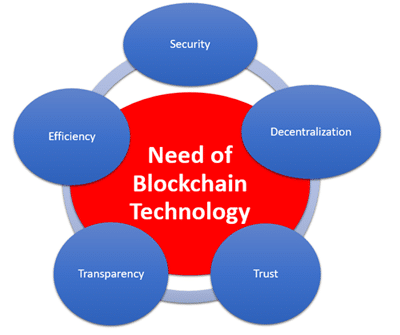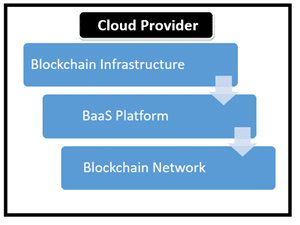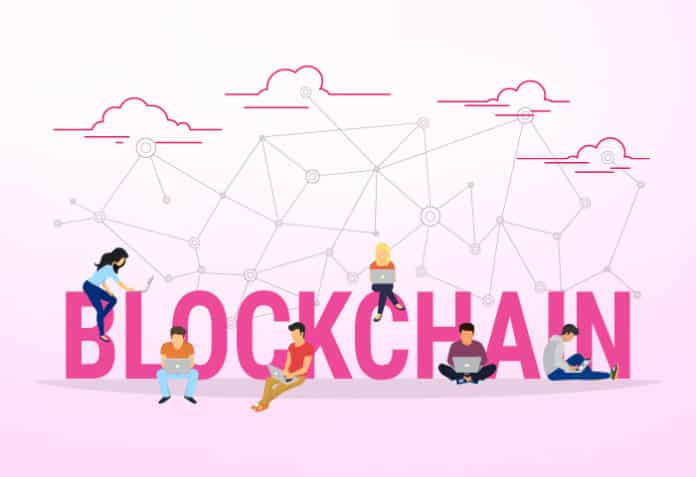The blockchain is a distributed database technology that allows for secure, transparent and tamper-proof storage and transmission of data. First introduced as the underlying technology behind Bitcoin, it has since been applied to a wide range of use cases, beyond cryptocurrencies. This article gives an overview of this technology and its applications. It also briefly describes the programming languages and toolkits used for blockchain development, as well as the cloud platforms that offer Blockchain as a Service (BaaS).
Blockchain technology provides a secure and transparent way to store and transmit data without the need for a central authority. This technology is particularly useful in situations where trust is a critical factor, such as financial transactions, supply chain management, and identity verification.
Application areas and use cases of blockchain technology
Cryptocurrencies: Blockchain technology is most commonly associated with cryptocurrencies, such as Bitcoin and Ethereum. These digital currencies use blockchain to securely store and transfer value without the need for a central authority, such as a bank.
Supply chain management: Blockchain technology can be used to track products and goods as they move through the supply chain. This can help improve transparency and accountability, reduce fraud, and increase efficiency.
Identity management: This technology can be used to create decentralised and secure identity management systems. This can help individuals control their identity information and reduce the risk of identity theft.
Voting systems: Blockchain technology can be used to create secure and transparent voting systems. This can help reduce the risk of fraud and increase trust in the electoral process.
Smart contracts: This technology can be used to create self-executing contracts, known as smart contracts. These contracts can automatically execute when certain conditions are met, without the need for intermediaries.
Healthcare: Blockchain tech can be used to securely store and share medical records. This can improve the accuracy and accessibility of medical data, while also protecting patient privacy.
Real estate: Blockchain technology can be used to create secure and transparent real estate registries. This can help reduce the risk of fraud and increase the efficiency of property transactions.
These are just a few examples of the many potential use cases for blockchain technology. As the technology continues to evolve, we can expect to see it applied to an even wider range of industries and applications.
Why we need blockchain technology
Blockchain technology provides a secure, transparent, and efficient way to store and transmit data, which can help reduce fraud, increase trust, and improve efficiency in various applications.
Security: Blockchain technology provides a high level of security by using advanced cryptographic techniques to protect data. Once data is recorded on a blockchain, it cannot be altered or deleted, making it resistant to fraud and hacking.
Transparency: Blockchain technology provides a transparent and tamper-proof way to record and track data. All participants in a blockchain network can see the same information, and each transaction is recorded in a permanent and unalterable way.
Decentralisation: The blockchain allows for decentralised data storage and transmission, meaning that no single entity has control over the data. This can help reduce the risk of censorship, corruption, and other forms of abuse.
Efficiency: Blockchain tech can help increase efficiency by automating processes and reducing the need for intermediaries. This can help reduce costs, speed up transactions, and increase transparency.
Trust: Blockchain technology can help build trust between parties by providing a secure and transparent way to record and track data. This can be particularly useful in situations where trust is critical, such as financial transactions, supply chain management, and identity verification.

Programming languages and toolkits for blockchain development
There are several programming languages and toolkits that are commonly used in blockchain development. Here are some of the most popular ones.
Solidity: Solidity is a programming language that is used to write smart contracts for the Ethereum blockchain. It is a high-level programming language that is similar to JavaScript and is designed to be easy to learn.
JavaScript: JavaScript is a popular programming language that is used for both front-end and back-end web development. It is often used to build decentralised applications (dApps) that run on blockchain platforms.
Go: Go is a programming language that is frequently used for building blockchain applications. It is known for its simplicity, speed, and concurrency features, making it a good choice for building decentralised applications.
Python: Python is a popular programming language that is used for a wide range of applications, including blockchain development. It is often used for building blockchain applications that require data analysis and machine learning capabilities.
C++: C++ is a powerful programming language that is used for building high-performance applications, including blockchain applications. It is often used for building blockchain nodes and other backend components.
In addition to these programming languages, there are several toolkits and frameworks that are commonly used in blockchain development. Some of these are listed below.
Ethereum: Ethereum is a popular blockchain platform that is used for building decentralised applications. It provides a variety of tools and frameworks, including the Ethereum Virtual Machine (EVM) and the Solidity programming language.
Hyperledger Fabric: This open source blockchain framework is designed for building enterprise blockchain solutions. It provides a modular architecture that can be customised to meet specific business needs.
Truffle Suite: Truffle Suite is a development framework for Ethereum that provides a suite of tools for building, testing, and deploying smart contracts. It includes the Truffle development environment, the Ganache blockchain emulator, and other useful tools.
Remix: Remix is a web based IDE that is used for developing and testing smart contracts on the Ethereum blockchain. It provides a user-friendly interface and a range of useful features, such as code highlighting, debugging, and testing.
The choice of language and toolkit will depend on the specific requirements of the project, as well as the preferences and expertise of the development team.
Cloud platforms for Blockchain as a Service (BaaS)
Blockchain as a Service (BaaS) is a cloud based service that allows businesses and individuals to develop, host, and use their blockchain applications without the need to build and maintain their own blockchain infrastructure. It provides a platform for users to create and manage blockchain based solutions, such as smart contracts, decentralised applications (dApps), and digital currencies, using pre-built blockchain components.
BaaS providers offer a range of blockchain services, such as network deployment, smart contract management, node management, data storage, and identity management. These services are typically provided through a user-friendly interface that simplifies the process of building and deploying blockchain solutions.
BaaS is particularly useful for businesses that need to build and deploy blockchain solutions quickly and efficiently, as it eliminates the need for complex development processes and reduces time-to-market. It is also beneficial for businesses that want to ensure the security and privacy of their data, as blockchain technology provides a secure and tamper-proof way of storing and transferring data.
You can see in Figure 2 that the BaaS platform is provided by a cloud provider such as Amazon Web Services (AWS), Microsoft Azure, IBM, or any other. The cloud provider manages the blockchain infrastructure, which consists of nodes and other components needed to run the blockchain network. The BaaS platform sits on top of the blockchain infrastructure and provides an easy-to-use interface for developers to create and manage blockchain networks. It abstracts away much of the complexity of setting up and managing a blockchain network, allowing developers to focus on building applications on top of the blockchain. Finally, the blockchain network is the actual distributed ledger that runs on top of the blockchain infrastructure. This network can be configured to support various consensus mechanisms, smart contracts, and other features depending on the needs of the application being built on top of it.

One of the key benefits of BaaS is that it allows businesses to experiment with blockchain technology without having to invest in expensive hardware or software infrastructure. It also enables them to focus on their core competencies while leaving the management of the blockchain infrastructure to a third-party provider.
Popular cloud platforms for blockchain programming
Amazon Web Services (AWS): AWS is a cloud platform that provides a wide range of services for building and deploying blockchain applications. It provides several blockchain-specific services, such as Amazon Managed Blockchain and Amazon Quantum Ledger Database, as well as more general services, such as compute, storage, and networking.
Microsoft Azure: Microsoft Azure provides several blockchain-specific services, such as Azure Blockchain Service, as well as more general services, such as compute, storage, and networking.
IBM Cloud: IBM Cloud is a cloud platform that provides several blockchain-specific services, such as IBM Blockchain Platform, as well as more general services, such as compute, storage, and networking. IBM’s BaaS platform supports multiple blockchain frameworks, including Hyperledger Fabric, Ethereum, and Stellar.
Oracle Blockchain Cloud Service: Oracle provides a BaaS platform that supports Hyperledger Fabric, Ethereum, and Corda.
R3 Corda: Corda is a distributed ledger platform designed for businesses that require high-throughput, privacy, and interoperability.
ConsenSys Quorum: Quorum is an enterprise-focused version of Ethereum that is designed to support private, permissioned networks.
NEM NIS1: NEM is a blockchain platform designed for enterprise use cases, with features such as multi-signature accounts, encrypted messaging, and a reputation system.
Chain: Chain provides a BaaS platform that supports Hyperledger Fabric and Corda, with a focus on data privacy and security.
Stratis: Stratis is a blockchain platform that provides support for both private and public networks, with a focus on enterprise use cases.
Baidu Blockchain Engine: Baidu’s BaaS platform supports multiple blockchain frameworks, including Ethereum and Hyperledger Fabric, and is designed to provide high scalability and reliability.
Google Cloud Platform (GCP): GCP is a cloud platform that provides several blockchain-specific services, such as Google Cloud Blockchain Templates and Google Cloud Spanner, as well as more general services, such as compute, storage, and networking.
A few other important cloud platforms for Blockchain as a Service (BaaS) are listed in Table 1.
Table 1: Additional platforms for blockchain development
| Platform | URL |
| Kaleido | https://www.kaleido.io/ |
| Venly | https://www.venly.io/ |
| Blockdaemon | https://blockdaemon.com/ |
| Xooa | https://xooa.com/ |
| Alchemy | https://www.alchemy.com/ |
When choosing a cloud platform for blockchain programming, it is important to consider factors such as ease of use, scalability, security, and cost. It is also important to consider the specific requirements of the project and the level of expertise of the development team.
One of the biggest challenges facing blockchain technology is scalability. As the users and transactions on a blockchain network grow, the network can become slower and less efficient. Research is underway to develop new scaling solutions, such as sharding and layer-two scaling, which could help blockchain networks handle larger volumes of transactions.
Interoperability is another challenge. There are many different blockchain networks and protocols, and they do not always work well together. Standards and protocols that can enable blockchain networks to interoperate with each other, allowing for more seamless transfer of data and value between networks, are being researched.
Security and privacy are also critical concerns for blockchain technology. Researchers are working on developing new cryptographic techniques and protocols that can enhance the security and privacy of blockchain networks. This includes developing new methods for authentication, encryption, and consensus algorithms. DeFi (decentralised finance) is a fast-growing sector of the blockchain industry that is focused on developing financial applications that run on decentralised blockchain networks. New DeFi protocols and applications are being developed, such as decentralised exchanges, lending platforms, and stablecoins.
As blockchain networks become more complex and decentralised, the question of governance becomes increasingly important. Research is underway to develop new governance models and frameworks that can ensure the security, stability, and fairness of blockchain networks.
The scope for research and development in blockchain is broad and multi-disciplinary, encompassing fields such as computer science, cryptography, economics, law, and more. As blockchain technology continues to evolve and mature, it is likely that new areas of research and development will emerge, while existing areas continue to be refined and expanded.









































































